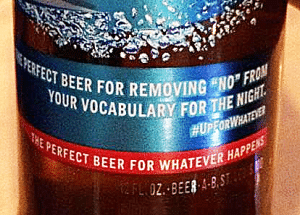
It is a given in today’s saturated media market, where consumers have countless choices, that PR and marketing execs must work hard to make sure their campaigns cut through the clutter and get noticed. Avoiding being boring can work both ways, though. What some brand managers think is edgy or awesome ultimately may come off as too cute by half, which can quickly erode a company’s reputation and deviate from its brand journey. As a result, PR has a critical policing role to play.
Bud Light apparently was trying to be anything but boring with a new marketing message on some of its beer bottles—and got burned in the process.
Once the heat intensified, Anheuser-Busch immediately ceased printing the message on its bottles, which read Bud Light is “the perfect beer for removing ‘no’ from your vocabulary.” The tagline—one of 140 messages Bud Light printed on bottles as part of its Up For Whatever campaign—got slammed on social media for contributing to rape culture. The word no has been associated with rape prevention campaigns for years.
PR AS THE BRAND PROTECTOR
The Bud Light incident raises several questions. Chief among them: How can PR pros navigate multiple disciplines to help companies avoid launching marketing and/or advertising campaigns that make the brand seem callous at best and culturally tone deaf at worst?
The label in question “gets away from the brand in a very critical way because for a tremendous amount of time Anheuser-Busch has been investing in [promoting] responsible alcohol consumption,” said Bill Nowling, senior partner at Finn Partners. The episode is another indication that, for many companies, PR and marketing teams are too removed from one another, he added.
“PR needs to ask, ‘What we’re proposing seems fun and cutting edge. But, in the end, is it undercutting what our brand really is?’” Nowling said. “Marketing is great about a lot of things, but PR understands how different audiences and different influencers will react. PR needs to protect the brand.”
We can assume that throughout the campaign, PR likely had an opportunity to speak up about the various beer labels. A critical question involves timing. Was PR consulted about the offending label before or after production began? It’s likely harder to speak out against a label once production has begun than it is to question it while it’s still a concept. Several executives reportedly vetted the label. Was PR among them and at what stage was PR consulted? Even so, with groupthink deeming the label appropriate, it might have been difficult to speak out against it.
Still, “you have to take the initiative if you think [a campaign] is dangerous and fall on the hand grenade,” said Steven Fink, president-CEO of Lexicon Communications Corp., a specialist in crisis communications whose clients have included Dr. Pepper, Labatt Breweries and 7-Up. “I’m not persuaded a PR person would say, ‘We can’t do this.’ Some have that clout, some don’t. PR must speak up with a mindset of including the entire creative team....At the end of the day, everybody has the same purpose.”
Author of “Crisis Communications: The Definitve Guide to Managing the Message” (McGraw-Hill Books, 2013), Fink added, “You have to build a mountain of empirical evidence to support your thinking that the campaign might cause damage. Advertising may be asking questions, but not the right questions. PR needs to focus on the gaps. That way, if [the campaign] blows up, the CEO will see PR was on the right track and will take PR more seriously.”
BETTER RISK ASSESSMENT
There were about 45,600 tweets about Bud Light from 12 a.m. April 28 through 12 p.m. April 30, compared with 3,900 tweets during the same period the previous week, according to data and analytics company ListenFirst.
We bet most of the tweets were negative. One person tweeted: “Budlight, the official beer of rape culture.”
In a statement, Alexander Lambrecht, VP, Bud Light, Anheuser-Busch, said, “It’s clear that this message missed the mark, and we regret it. We would never condone disrespectful or irresponsible behavior. No means no.”
The Up for Whatever campaign has landed Anheuser-Busch in hot water before, when the brand sent out a tweet letting followers know that you can “pinch people who aren’t #UpForWhatever,” according to The Washington Post.
“The fact that [Bud Light] had more than 140 scroll messages in itself shows both the difficulty and the risks organizations are taking to gain attention in hyper-noisy environments,” said Katherine Boettrich, senior VP at Hill+Knowlton Strategies. “And it demonstrates that no matter how successful a program has been, there is an unrelenting requirement for message vigilance...any misstep could have significant consequences.”
The brew’s “buzz” score took a temporary hit, but rebounded quickly. Bud Light’s buzz score fell to -2 on April 30, but on May 3 climbed back up to 3 (the average score for domestic beers is 4), according to YouGov BrandIndex, which measured daily brand consumer perception. “Consumers may be too sensitive, but that’s not an argument you can make if you’re a brand,” said Ted Marzilli, CEO of YouGov BrandIndex. “You have to deal with the reality.”
CONTACT: Katherine Boettrich, [email protected]; Steven Fink, [email protected]; Ted Marzilli, [email protected]; Bill Nowling, [email protected]
This article originally appeared in the May 11, 2015 issue of PR News. Read more subscriber-only content by becoming a PR News subscriber today.
